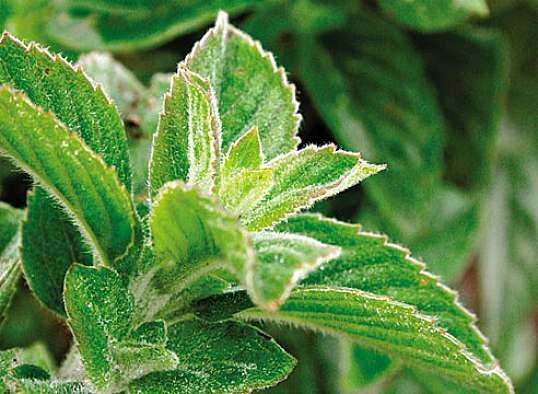The nutrients contained in the mint:
- carotene;
- vitamin C;
- vitamin P;
- potassium;
calcium;
magnesium;
- iron;
- esters;
- menthol;
- flavonoids;
- the bitterness of;
- tanning substances;
- tannins;
- betaine;
- ursulova acid;
- oleanolic acid;
triterpene compounds;
- hesperidin.
Mint in the nature and in the garden
More than 25 known species of mint found in nature, the most common are: peppermint water, donnaliza mint, field mint, Apple mint, mint flea. All these species are wild. If different varieties of mint grow and pollinate next to each other – to create hybrid varieties. The most known cultural sight – peppermint, it is a hybrid of water mint and peppermint Koloskova.
Spearmint and peppermint are cultivated plants that grow in the gardens, they have a decorative and commercial value. Spearmint leaf is used more in cooking, and pepper is for the preparation of drugs.
Peppermint was first received for the purpose of breeding in England of the 17th century, then it began to grow everywhere and applied in the form of medicines, fragrant therapeutic teas, decoctions, tinctures, charges.
For industrial purposes use so-called "black" peppermint has a dark red-purple stems and leaves, in folk medicine used and even "white" mint with light green stems.
Useful properties of mint and their application
Mint has anti-inflammatory, analgesic and vasodilating properties, especially a good effect on the gastro-intestinal tract, relieves bloating, stomach pain, eliminates nausea and heartburn, increases appetite. In addition, mint has choleretic effect, cleans the gall bladder stones, liver treats.
Peppermint acts as a diaphoretic for fever, soothes the nervous system, normalizes sleep and cardiac function. The plant is used for treatment of urogenital system, it helps with bronchitis and colds. Menthol, which is a component of peppermint, is used for nose drops, anti-inflammatory effect in the treatment of angina and pharyngitis. Mint is used in dentistry and also refreshes the mouth.
Mint is part of the gum which can sometimes substitute for toothpaste.
Menthol is a component of the outer menovazin analgesic, which relieves pain in muscles and joints. Peppermint essential oil is included breath mints, mint drops, such drugs as "Valokordin", "sage" and others. Menthol helps in the treatment of angina in a mild form of neurosis and in the composition of validol, drops of Zelenin. It is part of pills "Pektusin" that treat cough and sore throat.
Dried and fresh flowers and peppermint leaves are used in cooking gravies for meat dishes, soups and miscellaneous condiments. Mint used to make liqueurs, soft drinks, sweets, it makes a tasty tea.
The aroma and beneficial properties of mint are used in the manufacture of Soaps, shampoos, lotions, other perfumery products. Also, this plant has long been used in folk medicine.
The softened mint, rubbed with salt, helps to get rid of fungus between the toes. For skin care recommended teaspoon dried mint leaves, pour a glass of boiling water and infuse 40 minutes. Then strain the infusion and wipe over the face and body.
Contraindications
The use of mint is beneficial in most cases, but there are contraindications. This applies primarily to those who have found the individual intolerance of the plant. Mint is not recommended to use as tea or to take drugs with her, people with low blood pressure, varicose veins, and when anatsidnyh gastritis. Overdose of peppermint can cause nausea, headache.
